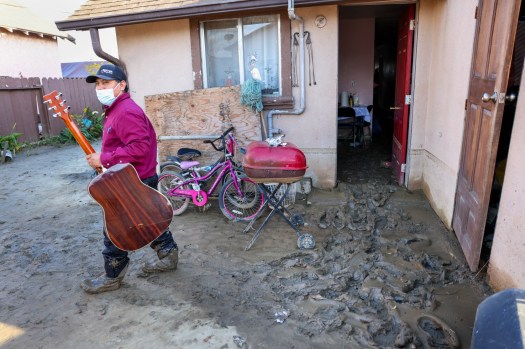California allocated $20 million each for the reconstruction of two small farmworker settlements that were inundated by flood waters during intense rainstorms in January 2023.
Four-fifths of the relief has still not been given to flood victims in Planada, Merced County, and even less has been given to Pajaro, Monterey County, nearly two years later.
A new atmospheric river soaking Northern California is causing anxiety for residents who have previously seen their neighborhoods destroyed, even though county officials and non-profit workers say the slow pace is due to a deliberate planning process and state regulations requiring verification of recipients’ residency and losses.
Canals and creeks overflowed in the two towns due to rainy days in January 2023, causing many inhabitants to suffer a triple whammy: losing their homes, having their belongings destroyed, and having their fieldwork hours reduced. The relief money were approved by state lawmakers in the fall of 2023. To pay for home repairs, business losses, infrastructure upgrades to get ready for the next storm, and reimbursement for wages and property, the counties split them up into different pools.
According to Merced County spokesperson Mike North, as of this month, roughly $4 million of the $20 million in state funds allocated for Planada has been used, with the majority going directly to families. About $1.3 million of Pajaro’s $20 million share has been distributed by county officials in collaboration with nonprofits. This includes $450,000 in grocery gift cards for residents whose food went bad during the floods, as well as roughly $800,000 for individuals and businesses who suffered more significant losses that were not covered by private insurance or federal disaster assistance.
One of the two groups engaged with Monterey County to assist Pajaro locals in applying for the funding is Catholic Charities Diocese of Monterey, whose executive director, Angela DiNovella, stated that her organization’s three case workers were giving out an average of $30,000 to families each week.
Verifying eligibility for families without a permanent residence or living in overcrowded situations, like when three family share an apartment, was one of the biggest obstacles, she said. Caseworkers were performing the laborious task of going through photos and attempting to determine the approximate monetary value of each item because some people found it difficult to record how much they had lost.
“The truth is that this is state funding, and it has many requirements,” she stated. Even being on the families’ side and being creative with them takes time.
In order to assist locals in applying for the assistance, Monterey County established an assistance center at a community park this past spring, according to DiNovella. However, many neighborhood people are still unsure of where the state funding is going and how to benefit, according to Danielle Rivera, a professor of environmental planning at UC Berkeley who does research in the region. She added that some might have left before receiving assistance.
The owner informed them that the unit they were renting was out of function after people were displaced by the floods. According to her, the family then looks for homes elsewhere, and it’s possible that they returned to Pajaro, moved to Watsonville, or simply departed the Pajaro Valley.
Undocumented residents of both cities could also be eligible for a statewide program called Storm Assistance for Immigrants, which was designed to assist flood victims in California who were not eligible for federal emergency aid. For hurricane victims, the $95 million statewide program provided a fixed stipend of $1,500 per eligible adult.
Since the floods, Pajaro has also received millions of dollars in additional aid from private insurance companies, philanthropic organizations, and the Federal Emergency Management Agency, according to county officials. However, residents’ access to this aid differed depending on whether they were homeowners or lawful residents of the United States.
According to North, the county in Planada was almost done allocating monies for the replacement of misplaced automobiles, personal belongings, and company assets, and was now proceeding to assist with home repairs. According to his email, the process takes longer since it depends on specific, in-depth inspections for problems like mold, foundation damage, asbestos testing, and in some situations, structural engineering may be needed.
According to North, infrastructure projects are also progressing, albeit more slowly. In addition to commissioning a study on ways to prevent future floods, the county has replaced a backup generator for the local community services district that failed during the floods.
According to Monterey County spokesperson Nick Pasculli, the county has asked for bids for almost half of the $20 million that Pajaro has set aside for emergency preparedness and infrastructure upgrades.
Communities sometimes take years to recover from disasters, and the glacial pace of relief in Pajaro is regrettably typical, according to DiNovella, whose organization also assisted families who had been affected by the 2020 fires in the Santa Cruz Mountains. Despite being delayed, the latest round of aid will help families get through the slow winter months when many farmworkers are struggling to make ends meet, she added.
Jess Padilla, a 25-year resident of Pajaro who works the blackberry and strawberry harvests, is one of the residents that received state assistance. He and his family barely had time to gather the birth certificates of the three children before fleeing when the floods struck. They lost everything, including kitchenware, clothing, and furniture.
The physical and mental well-being of his family is now his top concern. When it rains, his kids question him, “Where will we go if it keeps raining more?”
Many of his family’s possessions had already been replaced, but Catholic Charities assisted him in obtaining a state grant that partially covered their costs. Some of his pals are still in need of assistance.
He advises them to exercise patience. The procedure appears to be functioning. Slowly, please.
Note: Every piece of content is rigorously reviewed by our team of experienced writers and editors to ensure its accuracy. Our writers use credible sources and adhere to strict fact-checking protocols to verify all claims and data before publication. If an error is identified, we promptly correct it and strive for transparency in all updates, feel free to reach out to us via email. We appreciate your trust and support!




